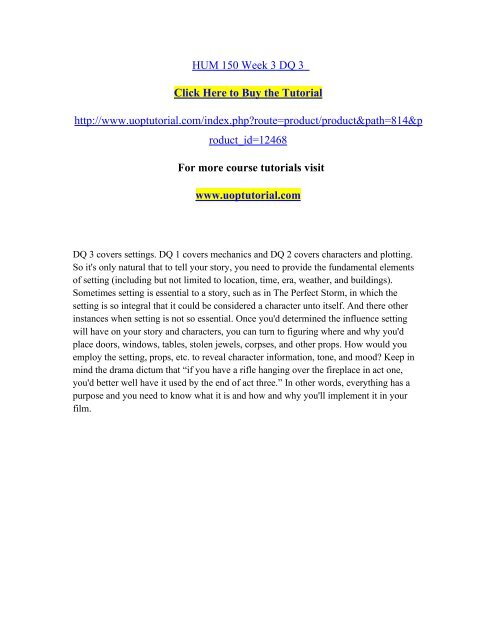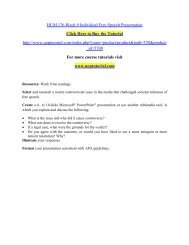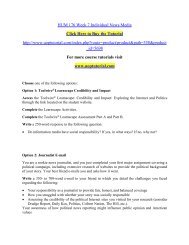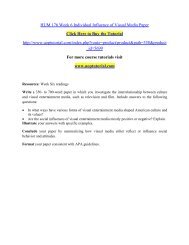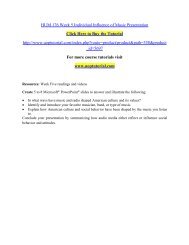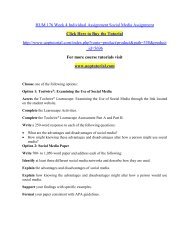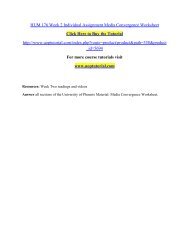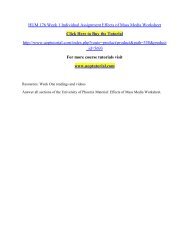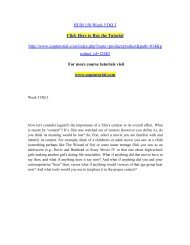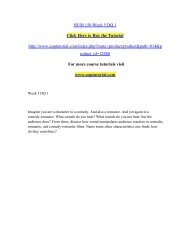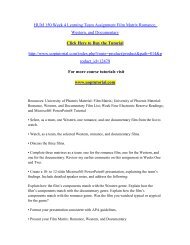HUM 150 Week 3 DQ 3
DQ 3 covers settings. DQ 1 covers mechanics and DQ 2 covers characters and plotting. So it's only natural that to tell your story, you need to provide the fundamental elements of setting (including but not limited to location, time, era, weather, and buildings). Sometimes setting is essential to a story, such as in The Perfect Storm, in which the setting is so integral that it could be considered a character unto itself. And there other instances when setting is not so essential. Once you'd determined the influence setting will have on your story and characters, you can turn to figuring where and why you'd place doors, windows, tables, stolen jewels, corpses, and other props. How would you employ the setting, props, etc. to reveal character information, tone, and mood? Keep in mind the drama dictum that “if you have a rifle hanging over the fireplace in act one, you'd better well have it used by the end of act three.” In other words, everything has a purpose and you need to know what it is and how and why you'll implement it in your film.
DQ 3 covers settings. DQ 1 covers mechanics and DQ 2 covers characters and plotting. So it's only natural that to tell your story, you need to provide the fundamental elements of setting (including but not limited to location, time, era, weather, and buildings). Sometimes setting is essential to a story, such as in The Perfect Storm, in which the setting is so integral that it could be considered a character unto itself. And there other instances when setting is not so essential. Once you'd determined the influence setting will have on your story and characters, you can turn to figuring where and why you'd place doors, windows, tables, stolen jewels, corpses, and other props. How would you employ the setting, props, etc. to reveal character information, tone, and mood? Keep in mind the drama dictum that “if you have a rifle hanging over the fireplace in act one, you'd better well have it used by the end of act three.” In other words, everything has a purpose and you need to know what it is and how and why you'll implement it in your film.
- No tags were found...
You also want an ePaper? Increase the reach of your titles
YUMPU automatically turns print PDFs into web optimized ePapers that Google loves.
<strong>HUM</strong> <strong>150</strong> <strong>Week</strong> 3 <strong>DQ</strong> 3<br />
Click Here to Buy the Tutorial<br />
http://www.uoptutorial.com/index.php?route=product/product&path=814&p<br />
roduct_id=12468<br />
For more course tutorials visit<br />
www.uoptutorial.com<br />
<strong>DQ</strong> 3 covers settings. <strong>DQ</strong> 1 covers mechanics and <strong>DQ</strong> 2 covers characters and plotting.<br />
So it's only natural that to tell your story, you need to provide the fundamental elements<br />
of setting (including but not limited to location, time, era, weather, and buildings).<br />
Sometimes setting is essential to a story, such as in The Perfect Storm, in which the<br />
setting is so integral that it could be considered a character unto itself. And there other<br />
instances when setting is not so essential. Once you'd determined the influence setting<br />
will have on your story and characters, you can turn to figuring where and why you'd<br />
place doors, windows, tables, stolen jewels, corpses, and other props. How would you<br />
employ the setting, props, etc. to reveal character information, tone, and mood? Keep in<br />
mind the drama dictum that “if you have a rifle hanging over the fireplace in act one,<br />
you'd better well have it used by the end of act three.” In other words, everything has a<br />
purpose and you need to know what it is and how and why you'll implement it in your<br />
film.


